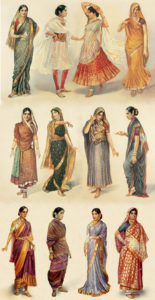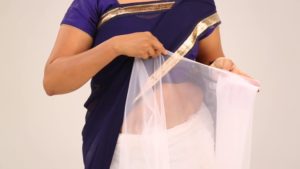A sari, saree, or shari[note 1] is a female garment from the Indian subcontinent that consists of a drape varying from five to nine yards (4.5 metres to 8 metres) in length and two to four feet (60 cm to 1.20 m) in breadth that is typically wrapped around the waist, with one end draped over the shoulder, baring the midriff. There are various styles of saree draping, the most common being the Nivi style, which originated in Andhra Pradesh.
The saree is usually worn over a petticoat or underskirt, with a fitted upper garment commonly called a blouse (ravike in South India and choli elsewhere). The blouse has short sleeves and is usually cropped at the midriff. The saree is associated with grace and is widely regarded as a symbol of grace in cultures of the Indian subcontinent.
Note 1: The name of the garment in various regional languages include:
Bengali: শাড়ি shaṛi, Hindi: साड़ी sāṛī, Odia: ଶାଢୀ sāddhi, Kannada: ಸೀರೆ, sīre, Konkani: साडी, कापड, चीरे, sāḍī, kāpaḍ, cīre, Malayalam: സാരി sāri, Marathi: साडी sāḍī, Nepali: सारी sārī, Punjabi: ਸਾਰੀ sārī, Tamil: புடவை puṭavai, Telugu: చీర cīra, Urdu: ساڑى sāṛī
Reference
How to drape a Saree?
Illustration of different styles of sari, gagra choli & shalwar kameez worn by women in South Asia:
How to care for your saree?
It is recommended that cleaning for the very first time Dry-clean a saree. It helps in longevity of the fabric life along with any print or embroidery designs.
Subsequently hand/ machine wash saree with mild detergent and let the saree air-dry away from direct sunlight.
Certain fabrics like cotton and viscose may require you to starch the saree for a crisp feel and drape.
Store in cool and dry place, may cover it with a muslin cloth or a saree cover.
Art of making saree pleats?
The secret to the grace of a draped saree is the neatness and decorative fall of the pleats. The vertical pleats are tucked into the waistband of the petticoat(bottom-wear worn underneath saree). They create a graceful, decorative effect which poets have likened to the petals of a flower. Also the pallu is heavily pleated and pinned on the shoulder for a professional style drape.
Stretch your left hand fingers holding the fabric with your thumb and pinkie finger. Wrap the fabric over the stretched fingers using your right hand and wind it through the thumb and pinkie holding with alternate fingers. You should end with 5 to 6 pleats or slightly more. Illustration:
Disclaimer: Images shown here are copyright to its respectful owners. If there is an image appearing on this page that belongs to you and do not wish for it to appear on this site, please E-mail with a link to said image and it will be promptly removed.

